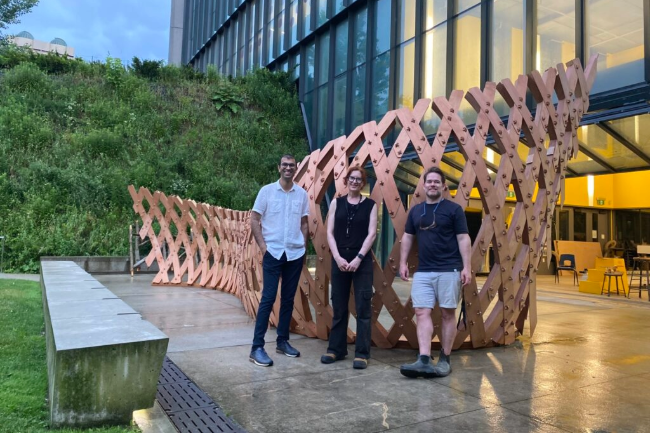This past June, U of T Engineering students, along with peers at the John H. Daniels Faculty of Architecture, Landscape, and Design, participated in Robot Made: Design Build, a hands-on design build project. The undergraduate and graduate participants engaged in research and active learning in the process of computational design and digital fabrication, while exploring techniques for designing, simulating and digitally fabricating timber systems.
The course was designed by Nicholas Steven Hoban, the director of applied technologies at Daniels, Professor AnnaLisa Meyboom from School of Architecture and Landscape Architecture at the University of British Columbia, and Professor Aryan Rezaei Rad (CivMin).
Design Build kicked off with classroom sessions, such as workshops, where participants delved into advanced wood design, robotic kinematics and systems. There, they explored digital workflows and engineering tools like parametric robot control (PRC) and COMPAS_FEA. The course shifted into high gear as students moved to their computers, crafting custom designs through scripting and modelling.
Then digital met physical: students stepped into the Kuka robotic cell, driving industrial robots to fabricate their creations. In the final days, the digitally crafted design came to life as the class collaboratively assembled a full-scale structure, experiencing the transformative power of digital fabrication and automation.
Through the Design Build course, students were able to explore cutting-edge applications in timber construction while developing advanced skills in design and assembly techniques.
Robot Made 2024 culminated in an installation of a pavilion at U of T, showcasing the collaborative efforts of the participants. This experience brought the design-to-fabrication process, typically confined to industrial settings, into an academic environment.
This project marked the first time students from both the engineering and architecture faculties at U of T collaborated to innovate in material usage, pushing the boundaries of construction methodologies. The resulting experimental structure exemplifies the potential of combining Design for Assembly principles with high-precision robotic fabrication and engineering-integrated computational design.
Robot Made forms part of a broader investigation into wood and mass timber construction, encompassing design for manufacturing and assembly (DFMA), as well as the development of open-source digital frameworks. These frameworks integrate simulation-based engineering science and timber engineering, considering the role of integrated data workflows and digital fabrication technologies in shaping the future of building with wood-based products.





